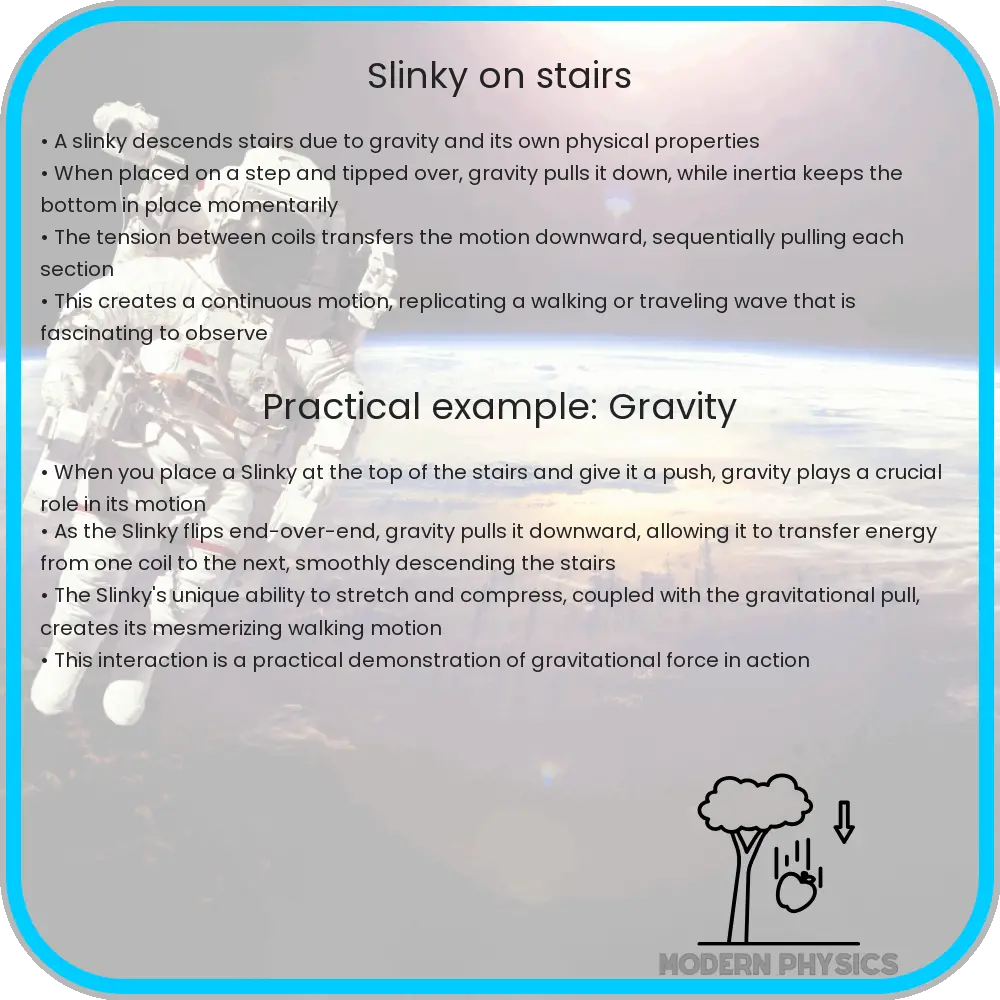Explore the fascinating physics of a Slinky on stairs, uncovering the principles of stability, balance, and load in this insightful article.

Understanding the Dynamics of a Slinky on Stairs: An Exploration of Stability, Balance, and Load Analysis
The iconic image of a Slinky gracefully descending a staircase captures the imagination and raises intriguing questions in physics. This seemingly simple toy, when placed on stairs, demonstrates a complex interplay of forces, balance, and stability. This article delves into the science behind the Slinky’s movement, exploring the principles of physics that govern its behavior.
Physics Behind the Slinky’s Descent
At the heart of the Slinky’s movement is the interplay between gravitational force, tension in the spring, and the physical characteristics of the stairs. When a Slinky is extended and released on the top step, gravity pulls it downwards. This initiates a wave-like motion as different parts of the spring experience varying degrees of tension and compression. The physical properties of the Slinky, including its mass, material, and coil spacing, significantly influence its motion.
Balance and Stability in Motion
The Slinky’s ability to maintain balance while transferring its mass from step to step is a marvel of dynamics. As the Slinky descends, its center of mass shifts continuously. The stability is maintained through a delicate balance between gravitational pull and the reactive force from the steps. This equilibrium is crucial for the Slinky to move in a controlled manner without toppling over.
Load Analysis and Energy Transfer
A critical aspect of the Slinky’s motion is the analysis of load and energy transfer. As the Slinky stretches and compresses, potential energy is converted into kinetic energy and vice versa. The distribution of load along the length of the Slinky varies dynamically, with the lower part carrying more weight as it stretches under gravity. This variation in load is pivotal in sustaining the motion, ensuring that each coil of the Slinky moves in a coordinated sequence.
Mathematical Modelling
Mathematically, the Slinky’s motion can be described using differential equations that account for forces such as gravity, tension, and friction. These equations provide insights into how variations in stair dimensions, Slinky properties, and environmental factors like air resistance impact its movement. Advanced models can even predict the behavior of the Slinky under different conditions, offering a deeper understanding of this fascinating phenomenon.
In summary, the Slinky’s journey down a staircase is more than just a captivating spectacle; it’s a rich example of physics in action, demonstrating principles of stability, balance, and energy transfer. In the next section, we will explore the applications of these principles in real-world scenarios and the educational value of this simple yet profound experiment.
Practical Applications and Educational Value
The study of a Slinky descending stairs transcends beyond mere curiosity, offering practical insights in various fields. Engineers and physicists can draw parallels between the Slinky’s motion and certain real-world applications. For instance, understanding how the Slinky distributes its load and maintains balance can inform the design of flexible structures or robotics that require similar dynamic stability.
Real-World Implications
In the realm of earthquake engineering, the principles observed in the Slinky’s motion can be applied to the design of buildings and bridges. These structures must withstand dynamic loads and maintain stability, much like a Slinky navigating the changing forces as it descends stairs. Similarly, in robotics, the concepts of balance and load distribution seen in the Slinky are crucial for developing robots that can navigate uneven terrain or perform complex tasks while in motion.
Educational Insights
The Slinky on stairs also serves as an excellent educational tool, introducing students to key concepts in physics. By observing its motion, students can learn about gravitational forces, potential and kinetic energy, and the principles of dynamics and stability. These concepts are foundational in physics and engineering and are more easily understood through this tangible demonstration.
Further Research Opportunities
This phenomenon also opens avenues for further research. Scientists and students alike can experiment with different materials, coil densities, and stair configurations to observe how these variables affect the Slinky’s motion. Such experiments can lead to a deeper understanding of the physical laws governing motion and stability.
Conclusion
In conclusion, the Slinky’s journey down a staircase is a captivating demonstration of physics in action. It encapsulates key principles such as gravitational force, tension, balance, and load distribution. The simplicity of this experiment belies its significance in providing insights applicable in fields like structural engineering and robotics, as well as its value as an educational tool. By exploring the dynamics of a Slinky on stairs, we gain a greater appreciation for the complexity and beauty of the physical world around us. This toy, a symbol of childhood wonder, thus becomes a gateway to understanding some of the fundamental principles that govern our universe.
